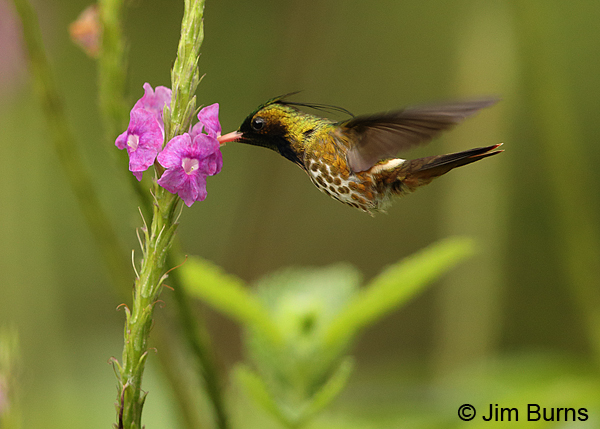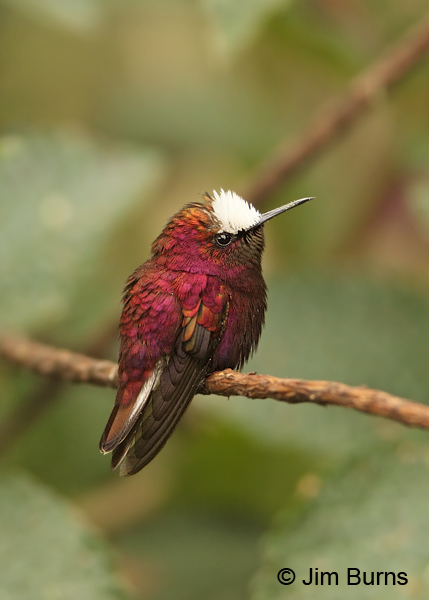
Most North American birders, when they begin to expand their birding horizons beyond the continental United States, invariably end up with a guide to Costa Rican birds in their hands. And they are immediately drawn to the exotic shapes and outrageous colors of tropical families such as toucans, trogons, and motmots. Sooner or later, though, they’ll stop short in a section with quite familiar shapes and colors, drawn in by the tantalizing array of common names assigned to this large family—names that drip off the tongue and fire the imagination. Sicklebill! Sabrewing! Woodnymph! Mountain-gem! Goldentail! Tropical hummingbirds that will have you thumbing your cell phone for the number of your travel agent.
North America hosts sixteen regularly occurring hummingbird species, and all sixteen of them are labeled “hummingbird” with just a preceding descriptive adjective or person’s name. Costa Rica boasts fifty-two hummers and over half of their names would give no hint, were it not for the accompanying images, that they belong to the beloved family of tiny, flying jewels that fascinate and amaze us. Fairy! Emerald! Coquette! Snowcap! Hermit! Costa Rican hummingbirds were apparently labeled by poets.
What Costa Rica’s hummingbirds add to our perception of North America’s most well known and photographed family of birds is variety, the spice of any birding life. A few measure in at six inches, larger than Magnificent, our largest, and several measure in at three inches, smaller than Calliope, our smallest. Costa Rica’s hummers are more colorful than ours and they combine those colors in smashingly unexpected patterns. Additionally, because they sport unimagined bill structures, tail extensions, or head plumes, some of these tropical gems usually end up at the top of Costa Rica first timers’ “want lists.”
In multiple birding trips to Costa Rica we now have seen forty-seven of that country’s fifty-two hummingbird species. Some of those forty-seven that I have not yet photographed well still sit on my want list, but two that I have nailed are species we and our guide agree are truly unique, even amongst Costa Rica’s plethora of hummer bounty--Black-crested Coquette and Snowcap. For our opportunities to see them we thank our guide, Steven Easley of Costa Rica Gateway and the small purple blooms of the Verbena plant which grows ubiquitously in hedgerows throughout the country. Both Black-crested Coquette and Snowcap are small (three inches), fast (both have been described as “bee like” in flight), and somewhat local in their distribution along the foothills on the Caribbean side of the country. The former is remarkable for its structure, the latter for its colors.
The coquette male rocks a head crest of wiry black feathers, a few long enough to extend beyond its nape, and these match the dark color of the throat, malar area, and chest. But, catch this guy face to face reflecting the sunlight, and that black throat pops into a fluorescent lime green gorget below the bill and a glowing forest green shield appears above it, a truly OMG moment, and the belly is pristine white speckled with large golden brown hearts! These accoutrements are all the more spectacular for their presentation on such a small package.
The male Snowcap is traditional hummerish in form, but its plumage is total eye candy. Though it sports only two colors, one of them is nearly indescribable. Let’s call it burnt raspberry. It covers the entire body except for a large frontal shield, and it shifts and morphs with each move the bird makes relative to angle of light. It can darken almost to black on the belly or lighten almost to rufous gold behind the eye. In a fleeting glimpse, a male Snowcap is just a dark streak . . . except for that shield. Did I mention the shield is, yes, snow white, and hence the common name. A birder could not concoct this color combination even if he were using verbena for “dream enhancement” as some native tribes are said to do.
Because the majority of Costa Rica’s hummer species are fairly widespread and almost every eco lodge has a hedgerow of Verbena, hummingbird observations are relatively frequent and easy. Our first Green Hermit, our first Blue-throated Goldentail, and our first violet- ears, both Green and Brown, were seen at Verbena. The Green Hermit bill is so long and decurved the bird has been called the Whimbrel of the hummer family. The Blue-throated Goldentail, like many hummingbirds, shows both its salutary colors only when the light is right, and the violet-ear males both have large patches of dark neon blue feathers below the eye extending across the nape. For hummingbird aficionados, these four birds alone are worth the price of a plane ticket.
For birders who would prioritize hummingbirds in Costa Rica, three stops are a must. The first of these is the beautiful La Paz Waterfall Gardens, an easy two hour drive north of San Jose where native flowers and multiple feeders attract twenty-six species of hummers. The other two are eco lodges, the Arenal Observatory Lodge near La Fortuna and Rancho Naturalista near Turrialba. It is no coincidence that both have extensive Verbena hedges and extensive hummingbird lists. At Arenal we have tallied sixteen hummer species and at Rancho fourteen while standing on the deck with feeders overlooking the purple Verbena flowering below.
The one problem with Costa Rica’s extensive Verbena plantings is that there is always a Rufous-Tailed Hummingbird in attendance. This is the most widespread and common Costa Rican hummer, but also the most aggressive (again, perhaps no coincidence), notorious for chasing away the more sought, less common and combative species, much to the chagrin of visiting birders. Aptly named and eye catching itself, this hummer cost me a couple days on trips as it persistently drove off smaller Magenta Woodstars, Green Thorntails, and Scintillants at flowers I had staked out with my camera.
Costa Rica is famous for its volcanoes and, as students of avian evolution might suspect, it boasts a hummingbird with three subspecies, one for each of its three highest volcanic areas. The three Volcano Hummingbird races, with gorgets ranging from scarlet through rose to purple, are designated by the names of the mountain district they inhabit. All are reminiscent of our Ruby-throated.
Usually the most memorable bird sightings are ones made in combination with special people or special adventures. Fittingly my wife, Deva’s, best Costa Rican hummingbird memory is of her first Fiery-throated Hummingbird, spotted as she hiked from a trailhead at 11,000 feet in the Cerro de la Muerte down to the Savegre Lodge at 7,200. Yes, the Fiery-throated is a high altitude species often considered Costa Rica’s “best” hummer with its spectacular array of forecrown, throat, and breast colors. Picture a flame burning brightest red in the center, fading out to orange, then yellow to green around the edges. And the bird’s breast and crown are iridescent blue, all this seen only if the light is just right. And on her hike down to Savegre it was.
Thinking about the Fiery-throated is the perfect antidote for a rainy, cold winter’s day in Arizona as we plan our next Costa Rica adventure. It’s going to include a lot of habitat for the White-tipped Sicklebill, the one specialty hummer there that we’ve missed, green with dark streaked white underparts and an extraordinary bill. The bill is short but sharply downcurved ninety degrees to its tip, allowing it to occupy a special niche feeding on Heliconia species with tubular blossoms curved to exactly match the shape of its marvelous bill. This is textbook evolutionary symbiosis.
Since I don’t have a photo yet, you’ll have to google it, but then we hope to see you in the field in Costa Rica looking for it.